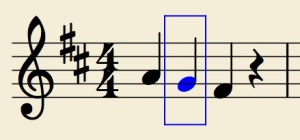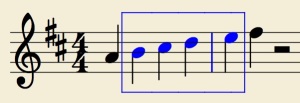At first it seemed like one of those moments when you’re working with a young student and they seem to say the most adorable things.
Me: [playing a descending line] “So what’s between A and F#?”
7-year-old student: [exaggerated sigh] “Oh gosh, where do I start?”
Adorable, right? I laughed and gently cajoled: “Come on, it’s just one note!”
And then the student gives me a confused look and goes on to list, quite resolutely: B, C#, D, and E.
Point taken! This little moment turned out to be a good reminder that what we think we’re saying isn’t always what students are hearing.
Since I had just played an example with a descending line, I assumed it was clear I was asking for this note:
But here’s what the student heard me ask for:
Two valid ways of hearing the same question, I’d say – especially with very young students, who tend to hear our words literally and on their own terms, with less reference to the context of those words.
This is a simple example, sure, but it made me start to think about other times the same phenomenon likely occurs – but with older students, ones who don’t react as helpfully (e.g. as obviously) as young ones do.
We’re pretty sure we know what our words mean but sometimes forget that those meanings might be more internal than we expect. So those things we say over and over again to our students (for flute players, it’s often “open your throat! center your tone! don’t clip the staccatos!”) – maybe once and again it’s worth asking if the problem isn’t that the student doesn’t get it yet, but rather that what the student gets from our words, and what we intend by them, just might turn out to be two different things.


